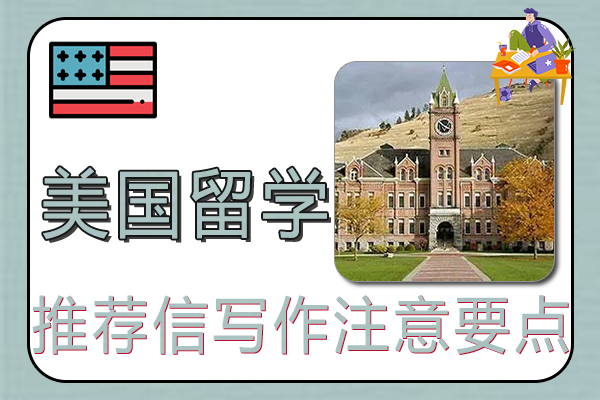A recommendation letter is an essential document for study abroad applications. It is an important document that complements the resume, personal statement and other application materials. If it is properly prepared, it can play an important role in the application.Tips for writing recommendation letters for studying in the United StatesRecommendation letter for studying in the United States, ,How many recommendation letters are needed for studying in the United States, ,How important is the recommendation letter for studying in the United States?, ,Recommendation letter for studying in the United StatesThe problem.

Tips for writing recommendation letters for studying in the United States
1. Important points to pay attention to when writing a recommendation letter for studying in the United States
- 1, try to use the official letter signature paper: that is, printed with the letterhead of the recommender's work unit, the school official paper, so as not to be seen by the school as a recommendation of the applicant this matter is not serious and not serious, affecting the recommendation effect. The signature at the end of the letter or electronic signature can be.
- 2, the length of the letter should be controlled: it is more appropriate to control it within one page of A4. Even if you have great enthusiasm for the applicant, you should pay attention to the wording and not write the letter too long, which will also have an impact on the recommendation effect.
- 3, avoid exaggerating, lack of practical content: perhaps accustomed to the domestic secondary school teacher's final evaluation, many letters of recommendation, although they take up a lot of space, but in fact, just a pile of adjectives lacking logic, put on anyone and accurate, so that after reading the applicant can not leave any deep impression. It is far more useful to give an example than to pile on the rhetoric!
- 4, overstating the applicant's ability: The most important thing for an undergraduate applicant is not past performance but future potential, and as a high school graduate most do not have superb academic performance either.
- 5, the content of the recommendation letter does not match the identity of the recommender: a pure high school math teacher could never know about the prose you published in a magazine under a secret pen name, or your school teacher does not know in detail the details of your piano studies after school.
- 6, duplication and redundancy of information in recommendation letters: several recommendation letters or recommendation letters and other materials are not distinguished from each other at a good level, resulting in a lot of information being mentioned repeatedly while some information of interest to the school is ignored.
- 7, the more letters of recommendation submitted is not the better: for example, some universities explicitly require applicants to provide only 2 letters, "to save time and to be fair to other students, we don't have extra time to read those extra ones." So, they often pick two random letters to read, and under the randomness, maybe those persuasive letters of recommendation of yours are not selected.
【Warm Tips】:Teachers are very busy, writing recommendation letters to you is only obligatory help, so in addition to phone and email requests to teachers, you must meet in person to communicate and explain.
2. Overview of undergraduate admission requirements for studying in the United States
1. English requirements for undergraduate study in the United States
TOEFL consists of four parts, namely Reading, Listening, Speaking, and Writing. Each part is worth 30 points, and the total score of the whole test is 120 points. Generally, you need to have a TOEFL score of 80-100 to apply for undergraduate studies. Some universities can provide students with dual admission. But be careful, if your TOEFL score is less than 75 points, you may not even be eligible for dual admission.
2. SAT/ACT for undergraduate study in the United States
SAT: It is an exam hosted by the College Board (CB) and is an important reference for applying for admission to American universities and scholarships. It and ACT (American College Test) are both called the American college entrance examination. However, some top universities do not require it. You should carefully check the admission requirements when applying.
ACT: This test is recognized by many American universities, mostly in the central and western regions. ACT is more like a subject test and is easier than SAT. Especially for Chinese test takers, choosing ACT may make it easier to get relatively satisfactory results in a short period of time. There are 7 states in the United States that require students to take the ACT test: Illinois, Colorado, Michigan, Kentucky, Wyoming, Tennessee, and Maine.
You can choose to take either the SAT or the ACT. Due to the epidemic, many American universities have also included the SAT or ACT as optional exams. However, it is still recommended that capable international candidates try to take the exam to prove themselves.
3. Document requirements for undergraduate study in the United States
The steps for applying to study in the United States are rather complicated, so you should prepare the required materials as early as possible in the UK, including PS, letters of recommendation, transcripts, certificates of deposit, personal documents/resumes, IELTS/TOEFL, SAT scores, school selection, extracurricular activities, interviews (depending on the school), portfolios, and other materials.
3. Introduction to U.S. study visa types
Type 1: F visa
This type of U.S. student visa is for international students who intend to pursue an academic degree at an accredited U.S. college or university, or to study English at a university or institution that provides English language enhancement. There are three types of F visas:
▪F-1 visa is for full-time students
▪The F-2 visa is for the dependents (spouse and unmarried children under the age of 21) of an F-1 visa holder, including spouses of the same sex.
▪The F-3 visa is for "border commuters" - students who live in Mexico and Canada in their country of origin, but attend school in the United States part-time or full-time.
Students with an F-1 visa may work on campus for 20 hours or less per week. Students who wish to work longer hours and work off-campus must obtain prior approval from the United States Citizenship and Immigration Services (USCIS) - they may also be authorized to work for Curricular Practical Training (CPT) and Optional Practical Training (OPT) for a full 12-month period, excluding the 90 days of unemployment.
Type 2: M visa
This type of US student visa is for international students who want to participate in non-academic, vocational studies or obtain training at an institution in the United States. There are three types of M visas:
▪M-1 visa is for students who are going to study vocational or non-academic courses
▪M-2 visa is for family members of M-1 visa holders (same as F-2 visa)
▪The M-3 visa is for "border commuters" and, like the F-3 visa, is for vocational or non-academic study.
Students on an M-1 visa are admitted to the U.S. for a fixed period of time - the length of their training program plus any optional practical training. They cannot stay in the U.S. for more than one year, except for medical extensions. M-1 visa holders are not allowed to work on or off campus during their studies, and cannot change status to an F-1 visa.
The third type: J visa
This last type of US student visa is for international exchange visitors who are participating in a US program to promote cultural exchange. Regardless of whether they are receiving medical, business, or other training, all applicants must meet the eligibility criteria for the program in question and be sponsored by a private sector or government program. J visa holders usually stay in the US for only a short period of time, perhaps 1 or 2 semesters. There are two types of J visas:
▪J-1 visa is for exchange students in related exchange programs
▪J-2 visa is for family members of J-1 visa holders (same as F-2 visa)
J-1 visa holders who are part of a government-sponsored exchange program will be subject to a two-year return-to-country residency requirement to pursue graduate medical education, training, or training that is included on the exchange visitor skills list (i.e., the J-1 visa holder's country of origin deems their expertise or skills necessary for the country's development). These requirements mean that J-1 visa holders will need to return to their country of origin at least two years after completing their exchange visitor program.
Summary of the key points to pay attention to when writing recommendation letters for studying in the United States
After understanding the key points to pay attention to when writing a recommendation letter for studying in the United States, you will also need to prepare an Internet tool to bypass the firewall and return to China when studying in the United States.For many Chinese who go to the US to study and work, they still like to watch some Chinese TV series and programs in China, and they are more accustomed to use some domestic native apps to listen to music, watch videos, play games and so on. However, due to copyright reasons, most of the popular programs are only allowed to be accessed by mainland IPs. In such a big background, theBack to China via the InternetQuickFox is the best choice for overseas Chinese to return to China, access domestic websites or applications, enjoy domestic music and video resources, and solve copyright and regional restrictions with one click.














